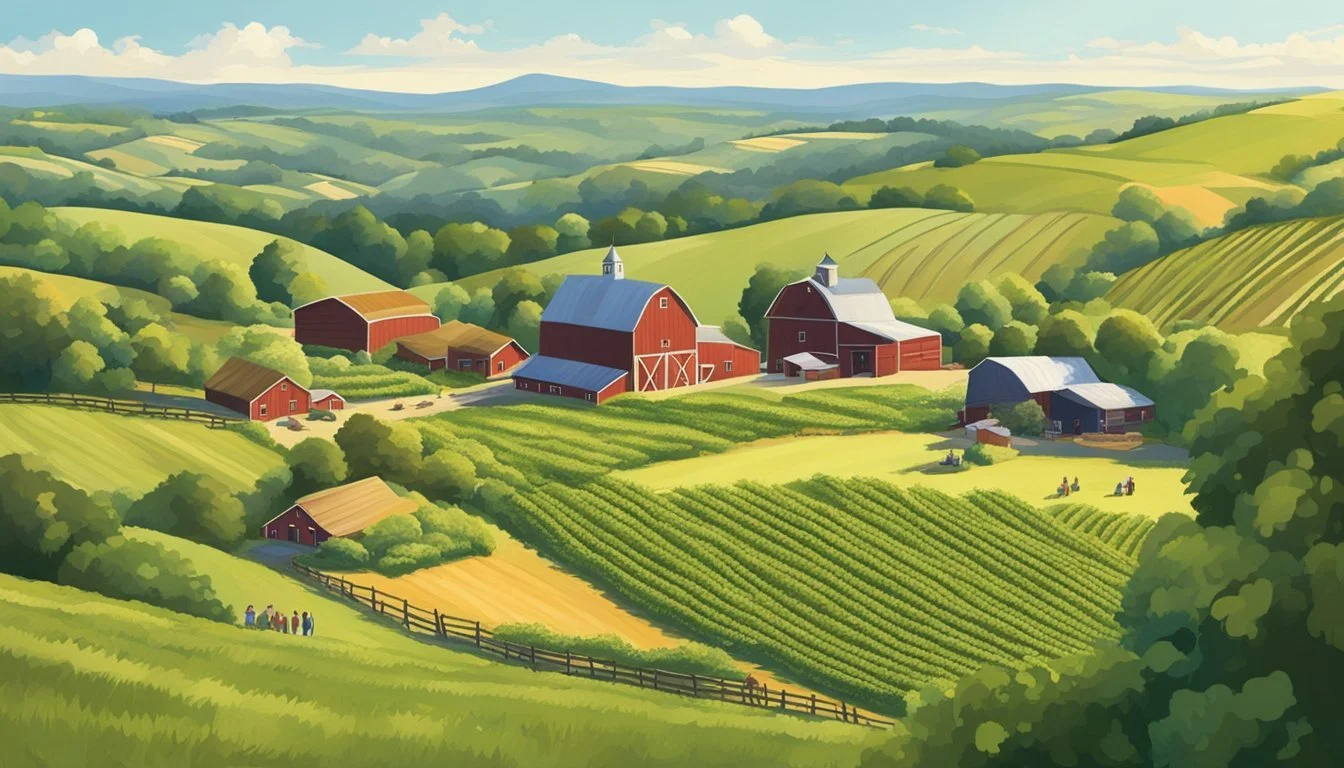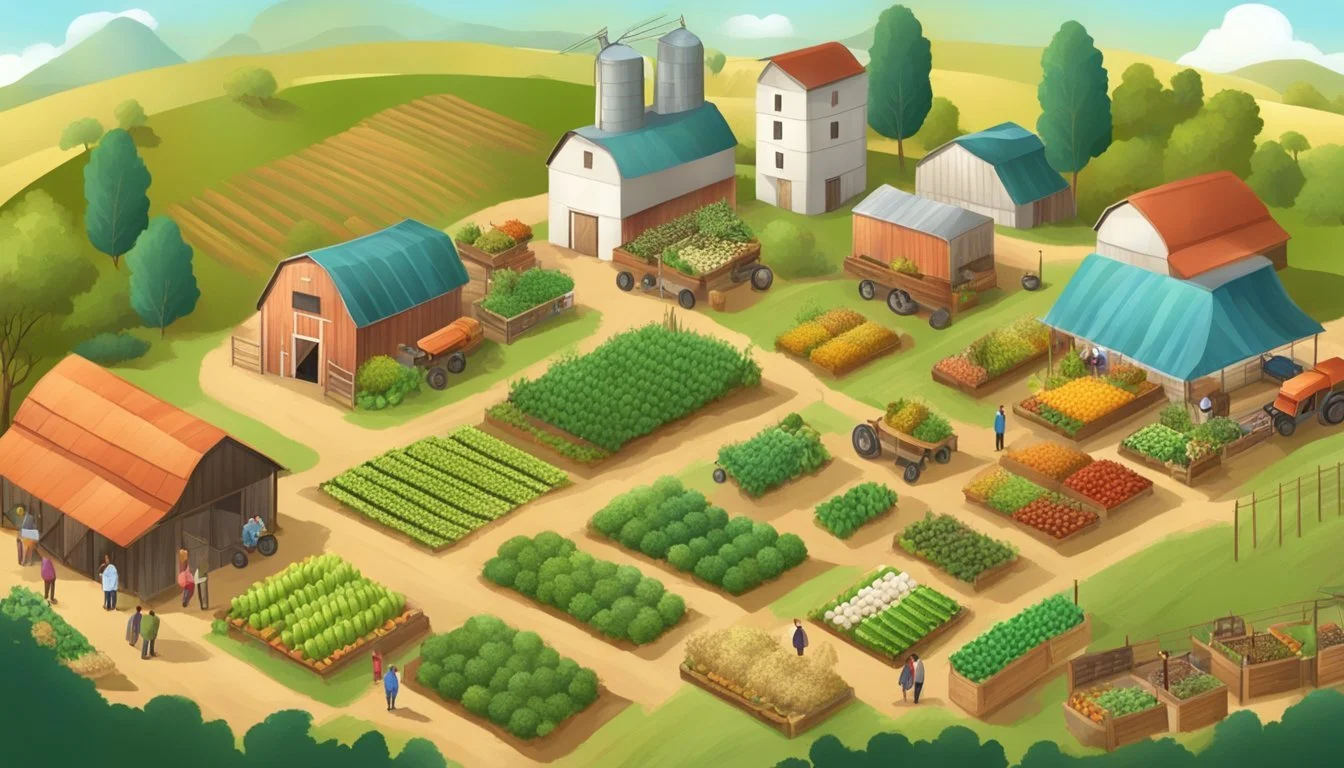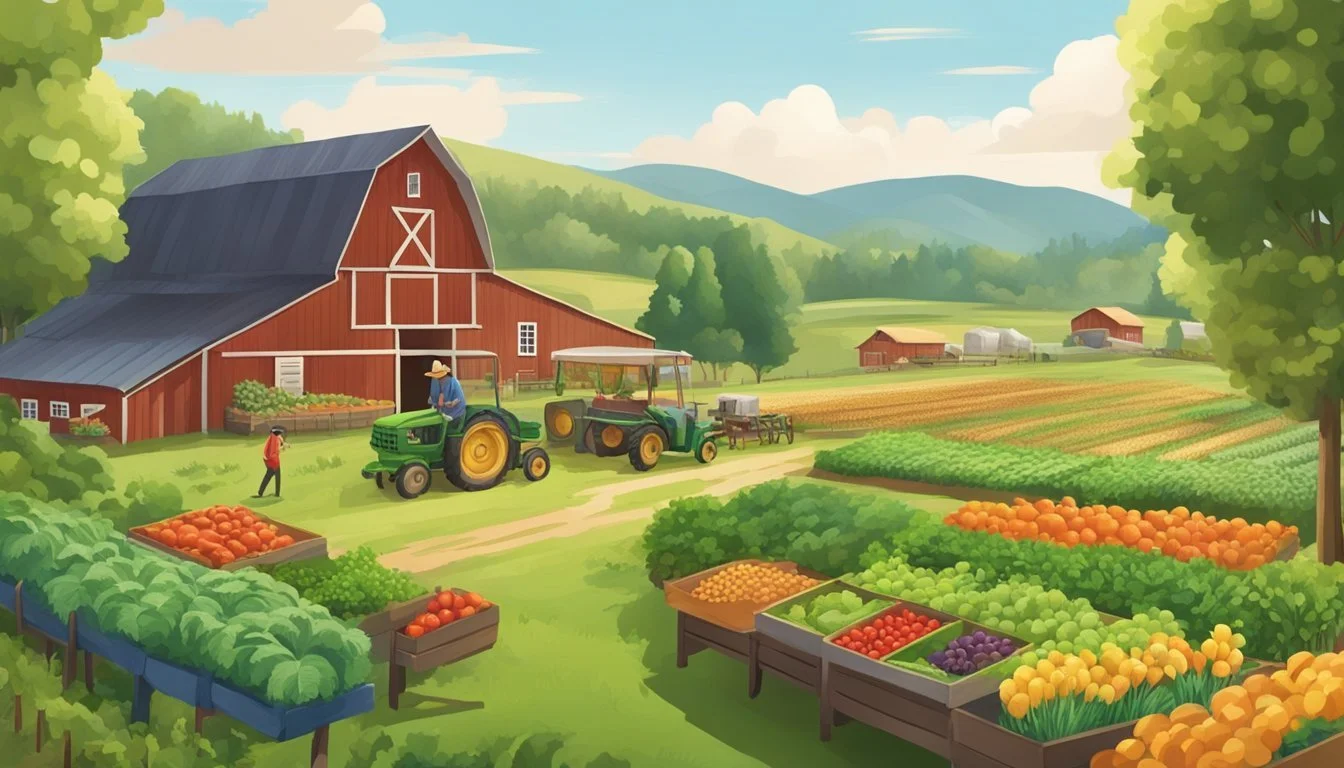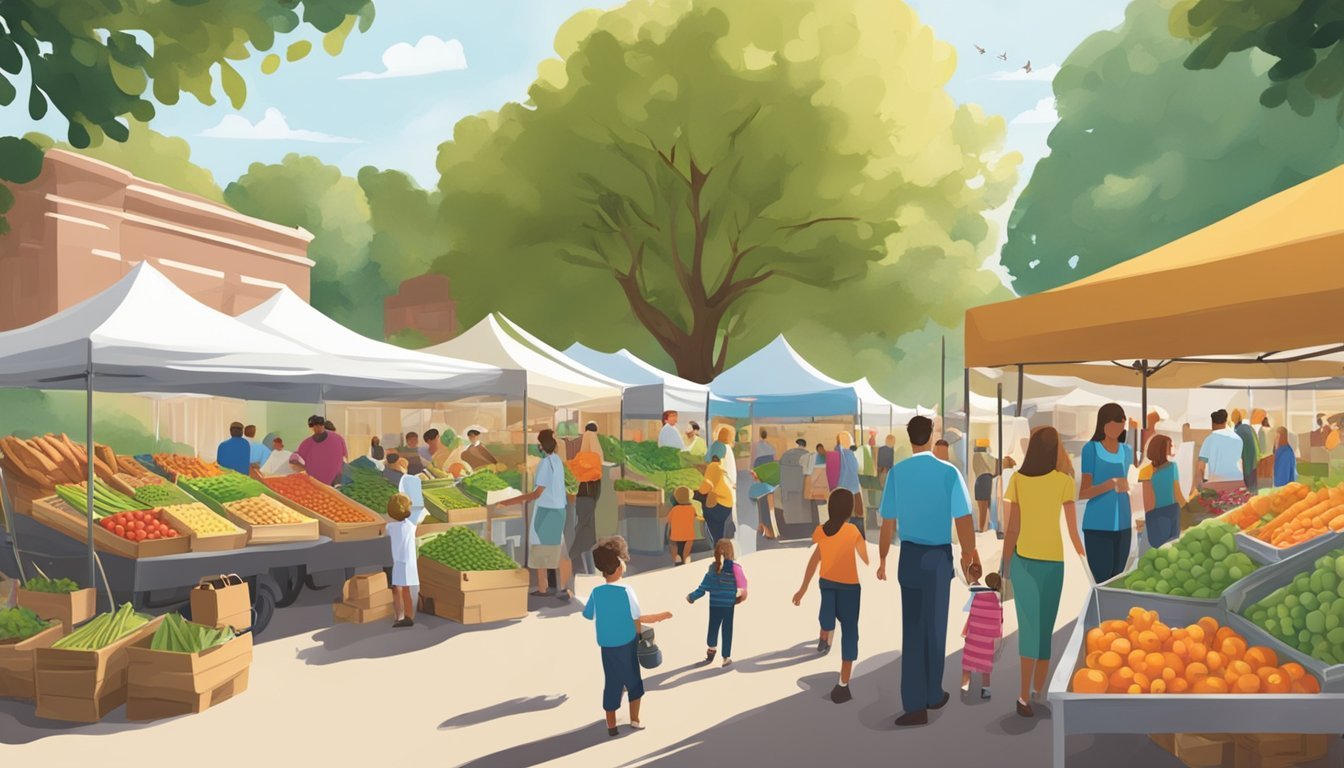Agritourism in Ohio
Exploring the Buckeye State's Rustic Charm
Agritourism in Ohio offers a refreshing blend of agriculture and tourism, providing visitors with an immersive experience into the heartland of America's farming culture. This burgeoning industry invites tourists to engage firsthand with the state's agricultural heritage. Many farms in Ohio have opened their doors to share their way of life, offering activities such as fruit and vegetable picking, farm-to-table dining experiences, and educational tours. From family-owned operations to larger agricultural enterprises, the variety of attractions caters to a wide range of interests, combining rural charm with learning opportunities.
Ohio's agritourism ventures are as diverse as the state's agricultural output. They include traditional family farms, markets like the Barn-N-Bunk Farm Market in Trenton, where visitors can peruse a range of homegrown products and handmade crafts. Additionally, there are seasonal festivals, farm stays, and vineyards that allow the public to connect with the land and its bounty. Winery tours and craft breweries like Fibonacci Brewing Company are becoming increasingly popular, illustrating the innovative ways Ohio farmers are diversifying and sharing their craft with the public.
The state’s unique agritourism experiences also encompass educational aspects, such as workshops hosted by Ohio State University Extension's Agritourism Conferences. These educational events ensure that the connection between agriculture and community remains strong. Moreover, initiatives like these suggest agritourism in Ohio is not merely a passing trend but an integral part of the state's forward-looking agricultural strategy, providing an engaging way for visitors to appreciate and understand the importance of agriculture to local and global food systems.
Overview of Agritourism in Ohio
Agritourism in Ohio represents a vital intersection of the state’s robust agricultural sector with its cultural and educational endeavors. It provides a platform for entertainment and learning, offering a diverse range of activities that both educates the public and boosts the local economy.
History and Significance
Ohio's agritourism dates back to its agricultural roots, where family farms started to diversify their offerings to educate the public about farming and to supplement their income. This movement has helped in preserving Ohio's farming heritage and has created avenues for cultural exchange. It underscores an ongoing commitment to connect Ohio's rural and urban communities through shared experiences.
Key Agritourism Activities
Agritourism activities in Ohio encompass a variety of interactive and engaging experiences:
Educational tours and workshops about farming techniques and food production.
Recreational activities like corn mazes, hayrides, and pumpkin picking.
Direct farm sales venues, such as farmer's markets and roadside stands.
Special events such as harvest festivals and cooking demonstrations.
Seasonal Events:
Spring/Summer: Berry picking and wine tastings.
Fall: Apple orchards visits and Halloween-themed events.
Winter: Holiday markets and tree farms.
Economic Impact
Agritourism significantly contributes to Ohio's economy. It provides farmers with an alternative revenue stream, thus stabilizing the agricultural community financially. It also impacts local businesses by increasing demand for local products and services. The unique blend of agriculture and tourism has created jobs, with establishments ranging from small family farms to larger agricultural enterprises playing pivotal roles in their local economies.
Popular Agritourism Destinations
Ohio offers a diverse range of agritourism destinations where visitors can enjoy local produce, artisanal foods, and handcrafted wines. From dynamic farm markets brimming with farm-fresh goods to picturesque orchards offering family-friendly picking experiences, the state presents an array of agricultural attractions.
Farm Markets and Wineries
Farm markets such as Barn-N-Bunk Farm Market in Trenton provide visitors with an assortment of homegrown produce, baked goods, and handcrafted items like baskets and furniture. These local markets serve as hubs for community engagement and offer a direct farm-to-table experience.
In addition to markets, Ohio boasts unique wineries that enrich the state's agritourism. Places like Fibonacci Brewing Company combine local agricultural products with expert brewing techniques, while destinations like Bokes Creek Winery invite guests to taste locally made wines in a serene setting.
Orchards and U-Picks
Groovy Plants Ranch in Marengo captures a laid-back, nature-centric atmosphere with inventive touches like a vintage Volkswagen Beetle planted with succulents. Such orchards provide an interactive experience where the visitors can immerse themselves in the farming world.
U-Pick orchards offer a hands-on approach to agritourism. They allow visitors to harvest their own fresh fruits such as peaches, apples, and berries, depending on the season. This activity not only allows guests to understand the origins of their food but also to engage with the agricultural process more intimately.
Agritourism Activities
Agritourism in Ohio offers a range of enriching activities that cater to educational purposes as well as recreational enjoyment, ensuring visitors have a multitude of ways to experience farm life and agriculture up close.
Educational Workshops and Tours
Educational workshops provided on Ohio farms focus on teaching visitors about agricultural practices and food production. From cheese-making classes to beekeeping seminars, these hands-on workshops impart practical skills and knowledge. Additionally, guided farm tours showcase the daily operations of a working farm, offering an informative perspective on livestock management and crop cultivation. For a more immersive experience, some farms offer a detailed exploration of specific processes, such as how milk goes from cow to carton.
Recreational Activities
Beyond education, Ohio agritourism invites guests to participate in recreational activities that embody the spirit of farm life. Corn mazes stand out as a signature attraction, offering fun and challenges for all ages as they navigate the twists and turns of a life-size puzzle. Visitors might also encounter hayrides, pumpkin patches, and harvest festivals, which provide entertainment while celebrating the season's bounty. These activities not only entertain but also foster a greater connection between consumers and the agricultural community, enhancing the appreciation for local farming efforts.
Business Considerations for Operators
Navigating the business landscape of agritourism requires a clear understanding of property taxation, zoning, and the legal framework. Operators must consider these elements to establish and maintain a successful enterprise.
Property Taxation and Zoning
Property Taxation: Operators should be aware that Ohio law may offer agritourism exemptions for property tax purposes, treating agritourism properties under agricultural use valuation. This can result in lower tax assessments, making it an important financial consideration for maintaining profitability.
Agricultural Use: Establishments that qualify as agritourism might still be categorized as agricultural land, which can impact property taxes. Operators should verify their eligibility for this categorization, as it can significantly affect operating expenses.
Local Zoning: Ohio law limits local zoning authority over agritourism but does not entirely eliminate it. Operators need to understand their local zoning regulations to ensure compliance and to take advantage of any agritourism-specific provisions that might facilitate their operations.
Legal Aspects of Agritourism
Liability: Agritourism operators in Ohio are protected from liability for injuries sustained from inherent risks of agritourism activities. For example, the unpredictable nature of animals is considered an inherent risk. Operators must display warning signs at their venues to notify participants of these risks, as failing to do so may negate these protections.
Agritourism Exemption: While some protection is afforded by state law, operators must still implement best practices to minimize risk. They should have waivers and clear signage to communicate risks to visitors.
Operator Responsibilities: Operations should ensure they have the proper insurance to cover activities not considered inherent risks. Staying informed about recent litigation and legal changes is crucial to managing an agritourism business effectively.
Agricultural Practices and Sustainability
Agriculture in Ohio is integrating sustainability and conservation into its core practices. The state promotes these methods to maintain environmental health and provide educational resources, fostering a well-informed agricultural community.
Conservation and Organic Farming
Conservation practices in Ohio aim to protect natural resources while supporting agricultural production. The Nature Conservancy works collaboratively with farms to implement sustainable agricultural practices. These methods include reducing soil erosion, managing water quality, and promoting biodiversity.
Organic farming is taking hold in Ohio as farmers adopt practices that eschew synthetic pesticides and fertilizers in favor of natural alternatives. This shift not only supports the environment but also caters to a growing segment of consumers seeking organic products.
Educational Resources from Universities
The Ohio State University Extension is pivotal in disseminating agricultural knowledge in the state. Through the College of Food, Agricultural, and Environmental Sciences (CFAES), they offer resources and programs on agritourism and sustainable agriculture. Farmers and educators can access cutting-edge research and best practices to enhance their operations and education.
OSU Extension’s agritourism programs provide opportunities for farmers to learn how to merge agriculture with tourism, creating educational experiences for visitors. This encompasses a range of subjects from sustainability practices to the economic aspects of running an agritourism farm.
Local Produce and Goods
Ohio's agritourism offers a bountiful selection of local produce and handcrafted goods, bringing farm-fresh experiences directly to consumers. Visitors encounter an array of organic products and delight in artisanal items that embody the state's agricultural diversity.
Organic Products and Nurseries
Local farms in Ohio take pride in their organic offerings, ensuring visitors have access to fresh, chemical-free produce. These farms often feature berries, including strawberries and blueberries, which are popular for u-pick activities. Additionally, nurseries provide a variety of annuals, herbs, and fruit-bearing plants that thrive in Ohio's climate, such as apples and pears.
Select Organic Farms and Their Offerings:
Berry Farms: U-pick strawberries, blueberries, and raspberries available seasonally.
Orchards: Apple and pear varieties ideal for both eating and cider-making.
Herb Gardens: Fresh herbs, including basil, thyme, and mint, often alongside educational tours.
Artisanal and Craft Goods
Artisanal markets at Ohio agritourism sites showcase an assortment of baked goods and crafts. The markets are replete with homemade pastries, breads, and pies, many of which utilize locally sourced fruits and grains. Craft goods at these markets may include hand-woven baskets, custom furniture, and unique floral arrangements, often made from local materials.
Examples of Artisanal Goods:
Baked Goods: Pies, breads, and pastries featuring local honey, apples, or berries.
Handicrafts: Baskets, furniture, and decorations crafted from local wood and fibers.
Visitors can enjoy the authenticity of buying products straight from the source, supporting Ohio's local economies and sustainable farming practices.
Agritourism and Entertainment
Agritourism in Ohio offers visitors diverse entertainment options ranging from events with live music to unique culinary experiences that often incorporate local produce and beverages.
Events and Live Music
Ohio's agritourism venues provide a rich array of events featuring live music, often set against picturesque backdrops of farms and fields. Visitors can enjoy the melodious tunes of local bands amidst the natural beauty of the countryside. An example is the Fibonacci Brewing Company, which pairs the experience of a nanobrewery with the enjoyment of live performances. This unique establishment emphasizes the connection between agriculture, craft beer, and entertainment.
Culinary Experiences and Tastings
Agritourism also invites guests to indulge in culinary experiences centered around Ohio's agricultural bounty. Many venues offer tastings where one can savor craft beers, such as those by Fibonacci Brewing Company, which not only produces beer but also showcases the role of honeybees in agriculture and brewing. Patrons can sample a wide range of craft beers while learning about the brewing process and the agricultural roots that support it. These tastings demonstrate how agricultural practices are woven into the fabric of Ohio's culinary scene.
Community and Education
Agritourism in Ohio serves as a vital bridge connecting the community to agricultural education and family-centric experiences. Through a variety of activities, these farms support both non-profit organizations and educational initiatives, fostering a deeper understanding of rural life among Ohioans.
Family-Oriented Activities
Ohio's agritourism destinations offer an array of family-oriented activities that are both engaging and educational. These activities range from pick-your-own fruit events to barnyard animal encounters, allowing children and adults alike to interact closely with farm life. Many of these farms are family-owned, reinforcing the importance of family in agricultural communities. For example, Thunder Hill Farms in Knox County not only produces a variety of crops but also turns agriculture into a learning experience for visiting families.
Educational Tours: Visitors can take guided tours to learn about farming processes, sustainability, and crop cycles.
Seasonal Events: Farms often host themed events such as pumpkin picking in the fall or flower festivals in the spring.
Support for Non-Profit Organizations
Agritourism is recognized as a platform for supporting non-profit organizations in Ohio. Farms collaborate with non-profits to host fundraising events, educational workshops, and volunteer opportunities, contributing to various causes within the community.
Fundraising Events: Farms donate a portion of their proceeds from tours and product sales to local charities.
Educational Outreach: Partnerships with institutions like Ohio State University extend educational resources to the public and non-profit sectors.
By engaging in these educational and community-oriented activities, agritourism in Ohio not only entertains but also enlightens the public on the significance of agriculture in everyday life.
Wildlife and Animal Interaction
Ohio's agritourism is rich with opportunities for guests to engage with farm animals, aiming to educate visitors and provide immersive experiences. Safety and animal wellbeing are paramount, with farms typically offering controlled environments where people can learn about and interact with various species.
Petting Zoos and Animal Farms
Petting zoos and animal farms are staple attractions within Ohio's agritourism sector, where interaction with animals such as goats and chickens is facilitated. These establishments not only contribute to the educational aspect of agritourism but also promote conservation and farming practices.
Safety Measures: Farms implement measures to ensure both animal and visitor safety. Proper fencing and supervised interaction areas are common, with staff often present to guide and inform visitors about the animals they are engaging with.
Health Precautions: Signage is important for communicating risks and reminding guests of hygiene practices. Hand-washing stations are typically available to prevent the spread of zoonotic diseases.
Animal Wellbeing: The health and comfort of the animals are top priorities. Food, shelter, and veterinary care are provided, alongside regular monitoring of the animals' behavior to ensure they are not stressed by human interaction.
The educational aspect is especially highlighted through information boards or guided tours, emphasizing the animals' roles on the farm and their care. Interaction with animals in Ohio's agritourism industry plays a significant role in connecting the public with agricultural life and promoting an understanding of where food comes from.
Challenges and Risks
In Ohio, agritourism presents unique challenges and risks, including managing inherent risks on the farm and ensuring the long-term viability of the business.
Managing Inherent Risks
Agritourism operators in Ohio face several inherent risks related to their activities. These risks include:
Surface and Subsurface Conditions: Variability in land conditions that could pose trip hazards or other dangers.
Structures and Equipment: Potential ordinary dangers associated with farm structures or equipment.
Animal Behavior: The unpredictability of domestic and wild animal actions, excluding issues with vicious or dangerous dogs.
To mitigate liability concerns, Ohio has enacted laws that provide agritourism operators with certain protections. Operators must ensure that the inherent risks are well-communicated to visitors and that steps are taken to manage these risks responsibly.
Long-Term Viability
Ensuring the long-term viability of an agritourism operation involves addressing several key factors:
Civil Liability Risks: Liability can affect the financial stability of a business. Ohio law offers some immunity to operators for injuries related to inherent risks, provided they have appropriately warned participants.
Property Taxation and Local Zoning: Understanding and complying with property tax laws and zoning regulations can influence long-term sustainability.
Operators must be proactive in understanding legal issues and crafting a sound business strategy that accounts for these various risks and challenges.
Connecting with Consumers
Agritourism in Ohio bridges the gap between rural and urban lifestyles by providing opportunities for consumers to engage directly with farming experiences. This engagement is facilitated through strategic marketing and the clever use of technology.
The Role of Social Media and Marketing
Marketing is pivotal in attracting visitors to agritourism venues. Social media stands at the forefront of this strategy, offering a platform for farms to showcase their activities. Through platforms like Facebook, Instagram, and Twitter, they can post real-time updates, harvest photos, and event advertisements. This visibility not only entices consumers but also builds a community around the agritourism experience.
Email marketing, although more traditional, remains effective. It allows for targeted messaging such as newsletters, which keep past visitors informed and engaged.
Creating an Effective Breadcrumb Menu
Breadcrumb menus on agritourism websites enhance user experience by allowing consumers to easily navigate and understand the structure of the site.
Structure of a Breadcrumb Menu:
Home > Category > Subcategory > Page
Consumers appreciate a well-constructed breadcrumb menu because it guides them back to previous pages without needing to use the back button or navigate through the menu again. This is especially useful for websites offering diverse activities and information, from pumpkin patches to educational farm tours. A clear breadcrumb menu fosters a seamless digital experience, encouraging consumers to explore all that Ohio agritourism has to offer.
Resources and Additional Information
For those interested in exploring Ohio's agritourism, a wealth of resources are available to guide and inform visitors and providers alike. From comprehensive maps to the latest industry developments, individuals can find detailed and current information to enhance their agritourism experience.
Useful Maps and Guides
Ohio State University Extension offers various maps and guides that serve as essential tools for navigating agritourism in Ohio. They provide:
Maps pinpointing agritourism locations, including farms with greenhouses and ponds.
Guides detailing best practices for safe agricultural tourism, especially pertinent during health crises.
Latest News and Developments
To stay updated on agritourism trends and legislation:
Ohio State University releases bulletins and papers analyzing recent laws and litigation affecting agritourism.
The U.S. Department of Agriculture publishes updates on agritourism sales and economic impact, providing a snapshot of the industry's financial health.
Regular checks on these resources ensure visitors and agritourism operators possess the most current information necessary for a fulfilling agritourism experience.
Conclusion
Agritourism in Ohio represents a growing sector, contributing substantially to the local economy and offering diverse experiences to visitors. Ohio State University plays an instrumental role in this development by providing vital resources and education through conferences and extensive research.
Economic Impact: Agritourism has been identified as a significant contributor to the agricultural sector's revenue, adding nearly $1 billion in sales, as noted in the 2017 Census of Agriculture.
Farms and Branding: Many Ohio farms are integrating agritourism into their business model, enhancing their brand and connecting with the community. These ventures allow for an authentic experience of the state's agricultural heritage.
Experiences Offered:
Farmers markets
Craft and food fairs
Educational tours
Legal Considerations: Ohio has implemented an agritourism immunity law that addresses the liability aspects, providing a layer of protection to agritourism providers against certain legal claims.
The sector’s continued growth is fostered by shared knowledge and support from institutions like OSU Extension and collective efforts within the community. Agritourism in Ohio not only supports local agriculture but also educates and engages the public in agricultural practices, creating a symbiotic relationship between farmers and visitors.












